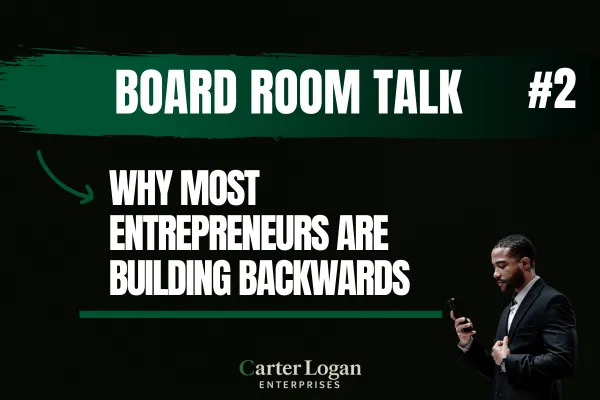
Why Most Entrepreneurs Are Building Backwards
And why it’s costing you time, money, and momentum.
Introduction: You’re Busy. But Are You Building the Right Way?
Let’s get this straight:
You're working hard.
You’re doing all the “right” things.
You’re in Canva. You’ve got the LLC. You’ve got a link in bio.
But still…
No traction.
No money.
No momentum.
Why?
Because you’re building backwards.
Most entrepreneurs focus on what looks good instead of what works.
They build a brand before a business.
They chase followers before cash flow.
They get busy… but not profitable.
Let’s fix that.
What Building Backwards Looks Like (And Why Most Do It)
The Typical Entrepreneur’s Path:
Create a logo
Launch an Instagram page
Pick colors and fonts
Set up a website
Post random content
Wait for clients to “find” them
Panic when nobody buys
It’s all image. No infrastructure.
They’re building the shell of a business with no engine inside.
Why do people do this?
Because it’s easier to design than it is to decide!
It’s easier to post than it is to plan.
It feels like progress — but it’s just noise.
What You Should Be Building First
Let’s flip the script. Here’s how you build like a real CEO:
1. Solve a Painful or Expensive Problem
If what you’re selling doesn’t solve pain, people won’t pay.
Ask yourself:
What keeps my ideal customer up at night?
What are they already spending money to fix?
Can I deliver a better or faster result?
You don’t need a pretty brand. You need a painful problem with a clear solution.
2. Build an Offer That Pays You Well
You don’t need 10 products. You need 1 that works.
A real offer:
Solves one core problem
Has a clear price, promise, and process
Can be delivered consistently
Creates margin (money left over after costs)
Stop building “services.”
Start building offers that move people to action — and cash into your business.
3. Create a Simple Business Model
How does money move through your business?
You need to be able to answer:
How do people find me?
How do they buy?
How do I deliver what I sold?
What happens next?
If you can’t map that out in 3 minutes, you don’t have a business model — you have a hustle.
4. Build the System Before You Brand It
Everyone wants to look like a business.
Few actually operate like one.
If your backend is messy, your marketing won’t save you.
You need:
Delivery systems
CRM setup
Sales process
Invoicing and cash flow clarity
Once that’s in place? Then build the brand.
Now your brand actually has something behind it.
Why You’re Tempted to Build Backwards
Let’s be real:
Branding is fun
Content is easy
Strategy is uncomfortable
Cash flow takes discipline
But the people who win in this game are not the most creative — they’re the most committed to clarity.
They build structure before style.
They prioritize delivery before design.
They build like they’re preparing for investors — even if they’re still in the early stages.
Because if it can’t scale, it’s not a business. It’s a hobby that makes money.
Final Word: Slow Down to Scale Up
If you feel stuck, overwhelmed, or like something’s just not clicking — it’s not because you’re not capable.
It’s because you’re building in the wrong order.
Here’s how to flip it:
Start with the pain
Build the offer
Design the model
Set up the systems
Then focus on branding, marketing, and scaling
Stop trying to go viral with something that’s not even viable.
You don’t need more hustle. You need a blueprint.
